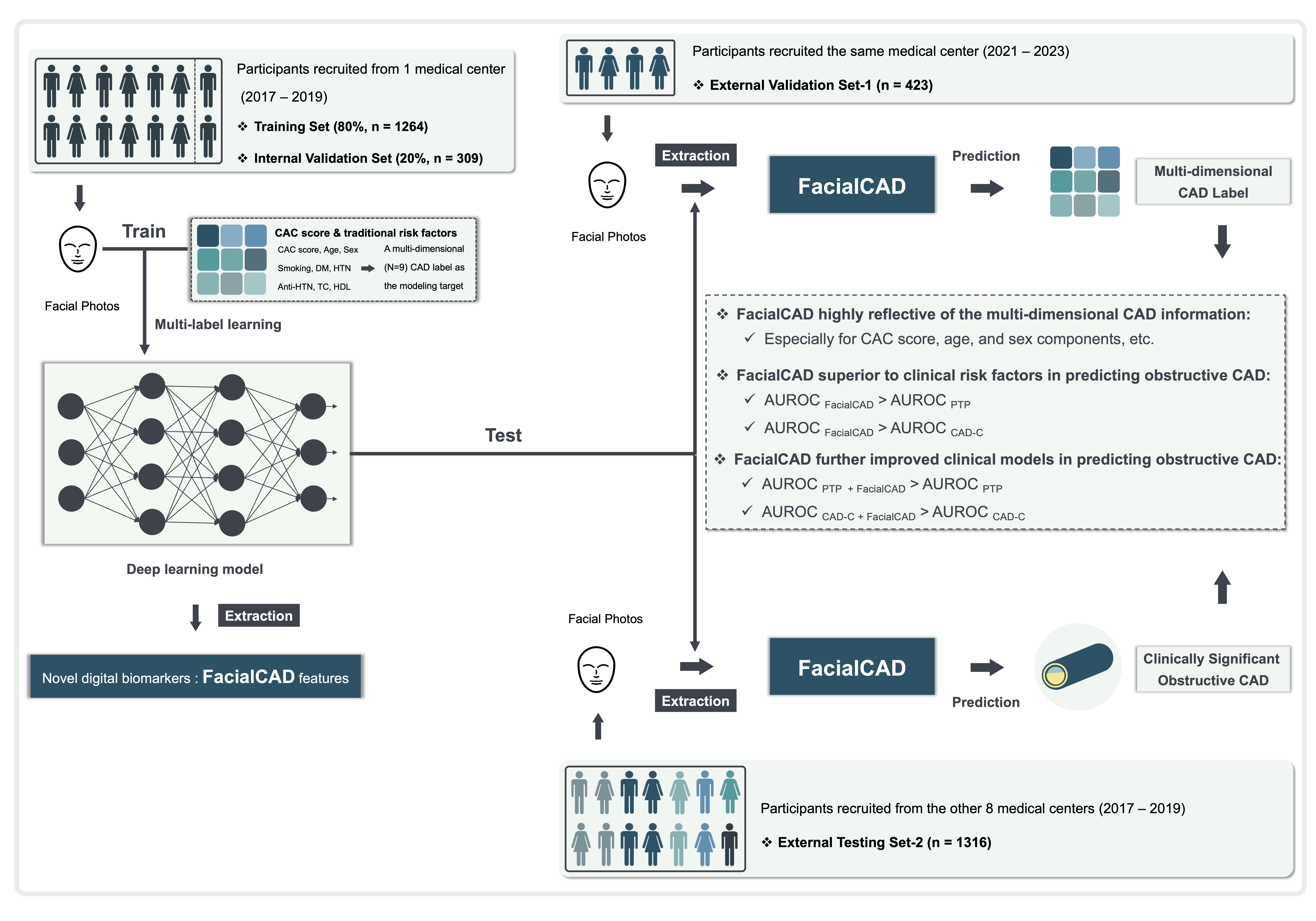Final ID: 4136032
Digital Biomarkers Associated With Coronary Artery Calcium And Traditional Risk Factors Extracted From Facial Photos Through Multi-Label Deep Learning For Detecting Coronary Artery Disease
Abstract Body (Do not enter title and authors here): Background
Biomarkers like coronary artery calcium (CAC) and traditional risk factors are well-validated for coronary artery disease (CAD) assessment but not always available, and with limited workup efficiency and potential radiation risk. Facial features contain biological information related to atherosclerosis.
Aims
We aim to extract CAC and traditional risk factor-associated digital biomarkers from facial images and evaluate their value in predicting CAD status compared with conventional clinical approaches.
Methods
Suspected individuals referred for confirmatory CAD evaluation across nine centers were included. Participants in one center constituted the derivation set. External validation included one dataset of participants from a different time period in the derivation center and the other dataset from the other eight centers. We developed a multi-label deep-learning model to extract digital biomarkers from facial photos based on a multi-dimensional label of CAC score and eight traditional risk factors to comprehensively represent coronary atherosclerosis risk profile. The extracted digital biomarkers were evaluated for both effectiveness in reflecting components of the multi-dimensional label and clinical value in predicting obstructive CAD.
Results
A total of 13248 facial photos from 3312 eligible participants (mean age, 58.5 years; 517 [25.9%] female) were included. In external validation, a set of digital biomarkers (FacialCAD) were extracted, effectively reflecting components of the multi-dimensional label, especially for CAC stratification (CAC>0, AUC 0.919 [0.885 – 0.949]; CAC≥100, AUC 0.906 [0.876 – 0.933]) and nearly perfect prediction for the age and sex. The performance of the FacialCAD in predicting obstructive CAD (AUC 0.721 [0.694–0.748]) significantly outperformed two guideline-recommended CAD models (0.721 vs. 0.653, P<0.001; 0.721 vs. 0.686, P=0.032), with further significant improvement when combined with these models (△AUC= +0.085, P<0.001; △AUC= +0.068, P<0.001).
Conclusion
FacialCAD, a set of CAC and risk factors-associated novel digital biomarkers extracted from facial images, exhibited superior and incremental value to conventional clinical approaches in predicting CAD status.
Biomarkers like coronary artery calcium (CAC) and traditional risk factors are well-validated for coronary artery disease (CAD) assessment but not always available, and with limited workup efficiency and potential radiation risk. Facial features contain biological information related to atherosclerosis.
Aims
We aim to extract CAC and traditional risk factor-associated digital biomarkers from facial images and evaluate their value in predicting CAD status compared with conventional clinical approaches.
Methods
Suspected individuals referred for confirmatory CAD evaluation across nine centers were included. Participants in one center constituted the derivation set. External validation included one dataset of participants from a different time period in the derivation center and the other dataset from the other eight centers. We developed a multi-label deep-learning model to extract digital biomarkers from facial photos based on a multi-dimensional label of CAC score and eight traditional risk factors to comprehensively represent coronary atherosclerosis risk profile. The extracted digital biomarkers were evaluated for both effectiveness in reflecting components of the multi-dimensional label and clinical value in predicting obstructive CAD.
Results
A total of 13248 facial photos from 3312 eligible participants (mean age, 58.5 years; 517 [25.9%] female) were included. In external validation, a set of digital biomarkers (FacialCAD) were extracted, effectively reflecting components of the multi-dimensional label, especially for CAC stratification (CAC>0, AUC 0.919 [0.885 – 0.949]; CAC≥100, AUC 0.906 [0.876 – 0.933]) and nearly perfect prediction for the age and sex. The performance of the FacialCAD in predicting obstructive CAD (AUC 0.721 [0.694–0.748]) significantly outperformed two guideline-recommended CAD models (0.721 vs. 0.653, P<0.001; 0.721 vs. 0.686, P=0.032), with further significant improvement when combined with these models (△AUC= +0.085, P<0.001; △AUC= +0.068, P<0.001).
Conclusion
FacialCAD, a set of CAC and risk factors-associated novel digital biomarkers extracted from facial images, exhibited superior and incremental value to conventional clinical approaches in predicting CAD status.
More abstracts on this topic:
AI-Driven Electrocardiographic Detection and Subtyping of Hypertrophic Cardiomyopathy: A Deep Learning Approach Using 12-Lead ECGs
Soh Moon Seung, Yu Taehyung, Na Yeongyeon, Joo Sunghoon, Shin Joon-han
Associations Between Absolute Blood Eosinophil Count and Subclinical Atherosclerotic Plaque in the Multi-Ethnic Study of AtherosclerosisMathis Nyla, Mcclelland Robyn, Stein James, Johansson Mats, Tattersall Matthew, Hansen Spencer, Dasiewicz Alison, Esnault Stephane, Siddiqui Salman, Mathur Sameer, Jarjour Nizar, Denlinger Loren

